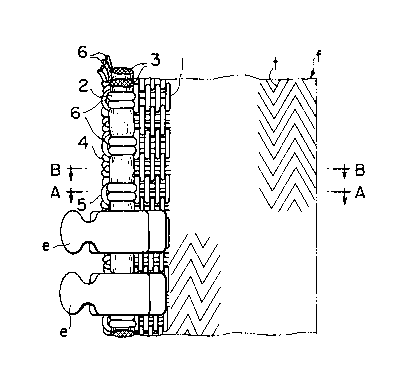Some of the information on this Web page has been provided by external sources. The Government of Canada is not responsible for the accuracy, reliability or currency of the information supplied by external sources. Users wishing to rely upon this information should consult directly with the source of the information. Content provided by external sources is not subject to official languages, privacy and accessibility requirements.
Any discrepancies in the text and image of the Claims and Abstract are due to differing posting times. Text of the Claims and Abstract are posted:
| (12) Patent: | (11) CA 2081988 |
|---|---|
| (54) English Title: | SLIDE FASTENER |
| (54) French Title: | FERMETURE-ECLAIR |
| Status: | Expired and beyond the Period of Reversal |
| (51) International Patent Classification (IPC): |
|
|---|---|
| (72) Inventors : |
|
| (73) Owners : |
|
| (71) Applicants : |
|
| (74) Agent: | GOWLING WLG (CANADA) LLP |
| (74) Associate agent: | |
| (45) Issued: | 1996-07-02 |
| (22) Filed Date: | 1992-11-03 |
| (41) Open to Public Inspection: | 1993-05-06 |
| Examination requested: | 1992-11-03 |
| Availability of licence: | N/A |
| Dedicated to the Public: | N/A |
| (25) Language of filing: | English |
| Patent Cooperation Treaty (PCT): | No |
|---|
| (30) Application Priority Data: | ||||||
|---|---|---|---|---|---|---|
|
A slide fastener comprising: a pair of woven or
knitted stringer tapes having a pair of core threads
extending in and along their confronting inner longi-
tudinal edges; a pair of rows of die-cast coupling
elements mounted on and along the confronting inner
longitudinal edges; and each of said stringer tapes
including a conductive wire extending along the
respective core thread on its side toward the inner
longitudinal edge, an edge warp yarn extending along
the inner longitudinal edge, and a weft yarn having a
succession of turnover portions arranged along the in-
ner longitudinal edge, said conductive wire together
with said edge warp yarn being incorporated into each
said stringer tapes by said turnovers in such a manner
that said conductive wire is partially concealed with
said edge warp yarn and said turnover portions.
Note: Claims are shown in the official language in which they were submitted.
Note: Descriptions are shown in the official language in which they were submitted.

2024-08-01:As part of the Next Generation Patents (NGP) transition, the Canadian Patents Database (CPD) now contains a more detailed Event History, which replicates the Event Log of our new back-office solution.
Please note that "Inactive:" events refers to events no longer in use in our new back-office solution.
For a clearer understanding of the status of the application/patent presented on this page, the site Disclaimer , as well as the definitions for Patent , Event History , Maintenance Fee and Payment History should be consulted.
| Description | Date |
|---|---|
| Inactive: Reversal of expired status | 2012-12-10 |
| Time Limit for Reversal Expired | 2012-11-05 |
| Letter Sent | 2011-11-03 |
| Letter Sent | 2009-03-05 |
| Inactive: Payment - Insufficient fee | 2008-12-15 |
| Inactive: Office letter | 2008-12-15 |
| Inactive: Late MF processed | 2008-11-05 |
| Letter Sent | 2008-11-03 |
| Inactive: IPC from MCD | 2006-03-11 |
| Grant by Issuance | 1996-07-02 |
| Application Published (Open to Public Inspection) | 1993-05-06 |
| All Requirements for Examination Determined Compliant | 1992-11-03 |
| Request for Examination Requirements Determined Compliant | 1992-11-03 |
There is no abandonment history.
| Fee Type | Anniversary Year | Due Date | Paid Date |
|---|---|---|---|
| MF (patent, 5th anniv.) - standard | 1997-11-03 | 1997-10-16 | |
| MF (patent, 6th anniv.) - standard | 1998-11-03 | 1998-08-14 | |
| MF (patent, 7th anniv.) - standard | 1999-11-03 | 1999-08-18 | |
| MF (patent, 8th anniv.) - standard | 2000-11-03 | 2000-08-10 | |
| MF (patent, 9th anniv.) - standard | 2001-11-05 | 2001-10-17 | |
| MF (patent, 10th anniv.) - standard | 2002-11-04 | 2002-10-17 | |
| MF (patent, 11th anniv.) - standard | 2003-11-03 | 2003-10-16 | |
| MF (patent, 12th anniv.) - standard | 2004-11-03 | 2004-10-07 | |
| MF (patent, 13th anniv.) - standard | 2005-11-03 | 2005-10-06 | |
| MF (patent, 14th anniv.) - standard | 2006-11-03 | 2006-10-06 | |
| MF (patent, 15th anniv.) - standard | 2007-11-05 | 2007-10-09 | |
| MF (patent, 16th anniv.) - standard | 2008-11-03 | 2008-11-05 | |
| Reversal of deemed expiry | 2008-11-03 | 2008-11-05 | |
| MF (patent, 17th anniv.) - standard | 2009-11-03 | 2009-10-14 | |
| MF (patent, 18th anniv.) - standard | 2010-11-03 | 2010-10-25 |
Note: Records showing the ownership history in alphabetical order.
| Current Owners on Record |
|---|
| YKK CORPORATION |
| Past Owners on Record |
|---|
| MASAHIRO KUSAYAMA |
| SHUNJI AKASHI |
| TSUTOMU YONEZAWA |